Gordon Murray Says The T.50 Fixes All the Mistakes of the McLaren F1

Someday we will get a quiet sit-down with Gordon Murray, Dario Franchitti, and the T.50 hypercar, but Saturday at WeatherTech Laguna Seca during Car Week was not it. Murray’s pit was surrounded by fans of both the cars, and their creator. The T.50 sat front and center, flanked by display engines and the elegant Brabham F1 car. In the background, vintage Trans Am cars roared down the corkscrew, and people nudged and pushed each other to get a closer look at the T.50’s three-seater interior.
To the dude I straight body-checked as he entered my video of the remote door operation demonstration, sorry. Sorta.
Despite the chaos, Murray was a granite cliff of calm, stately, expertise. He walked me around the T.50 and its tightly packaged gem of a V-12, and pointed out his favorite details, while still taking time to sign programs for fans. I’ve done my best to re-create the conversation, sans most of the interruptions.
Simari Photography LLC|Car and Driver
We started at the backside of the T.50.
Car and Driver: What prompted the decision to make such a high-dollar, low-volume car in the first place?
Gordon Murray: We looked around and thought, nobody’s really done another F1. I honestly don’t know why not. There were a couple of very good cars, you know, there was the Porsche Carrera GT and there was the Ferrari F50, but nothing with a central driving position, with a fantastic V-12. So we thought, okay, let’s do another one.
Was that a discussion that had to happen with McLaren? They don’t own intellectual property rights to the idea of this sort of car?
No, not at all. It wasn’t an issue. So, basically, this is a McLaren F1 30 years on, with all the latest materials, systems, and technology.
What sort of things were you able to do with this car that were not available when you did the F1?
Materials and technologies moved on a lot. But I also took the opportunity to fix the mistakes on the F1.
I’m sure everyone is curious to know what you think were the mistakes on the F1.
There were quite a few. The brakes never worked really well. The air conditioning didn’t work very well. The clutch needed adjusting regularly. The fuel tank needed changing every five years. And then from an aesthetics point of view, there were always a few things on the F1 that I really didn’t like.
One of them, for example, was this spine. [He points to the back of the T.50, where a slim backbone-like ridge runs from the roofline through the window and flares out into the aero-fan at the rear.] This spine was just about two inches too wide on the F1. And I had a very low budget and a very short time [with the F1]. When I finished the tooling, I would have loved to have changed those things, but I couldn’t. And every time I see an F1, it grates.
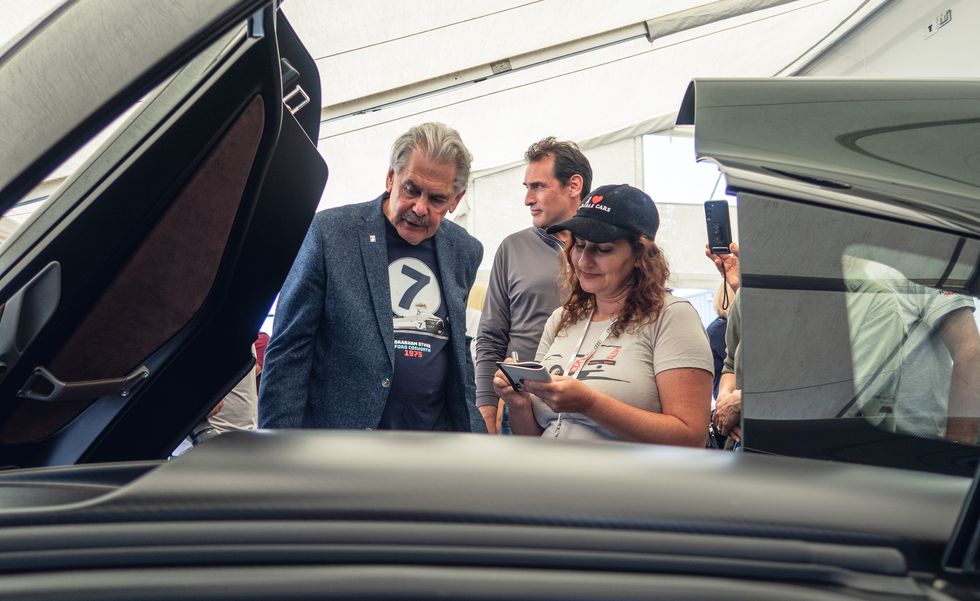
Simari Photography LLC|Car and Driver
Just for the record, I think the F1 looks great.
It stood up pretty well. But I managed to fix the things that I didn’t like. For example, the back of the F1 is quite slabby. It’s sort of flat. I’ve always liked cars with muscles over here [he pats the very curvy rear fender of the T.50]. Because I do the styling and the engineering, which is pretty unique. [Here we get distracted on a side conversation trying to name other designer/engineers, which ends when Murray laughs and calls himself “the last of the dinosaurs.”] So, because of that, I was able to get a lot more muscle and shape in this. But having said that, the basic ethos of the level of engineering and overall focus on the driving elements of the motorcar and the ownership element of the motorcar has not changed in 30 years. This is trying to do exactly what the F1 did in ’92.
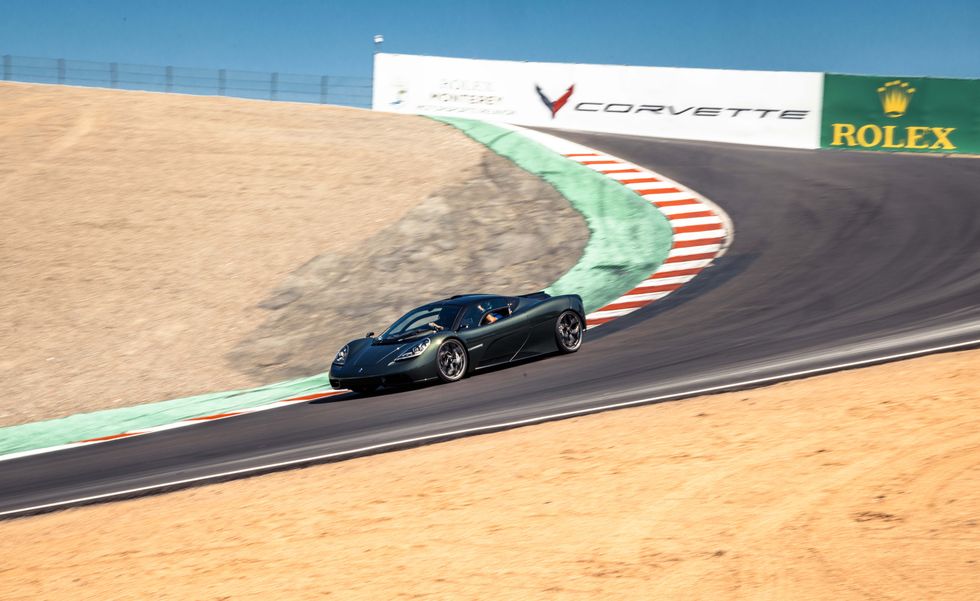
GMA
You mentioned better materials. What specifically?
It’s actually systems too. We 3D print a lot of stuff. And of course, that didn’t exist in 1990. The materials, particularly in the engine and transmission, allow us to get much, much more extreme. For example, when we did the F1, BMW designed us a brand-new engine, and I said it must rev higher than Ferrari. Ferrari at the time was 7300 rpm. So we got to 7500 rpm.
[Another interruption, this time from retired IndyCar champ Dario Franchitti, who has worked with Murray on the development of the T.50.]
Dario Franchitti: Not that you’re competitive or anything.
Gordon Murray [ignoring Franchitti]: This thing revs to 12. Cosworth [The T.50 uses a commissioned 4.0-liter V-12 designed by Cosworth with input from Murray], they make their own pistons out of ceramic and aluminum mixed together, they’ve got plasma coated skirts. There is ceramic inside the aluminum from a molecular point of view. The valves are titanium and hollow. And you need all that stuff to get to 12,000 revs.
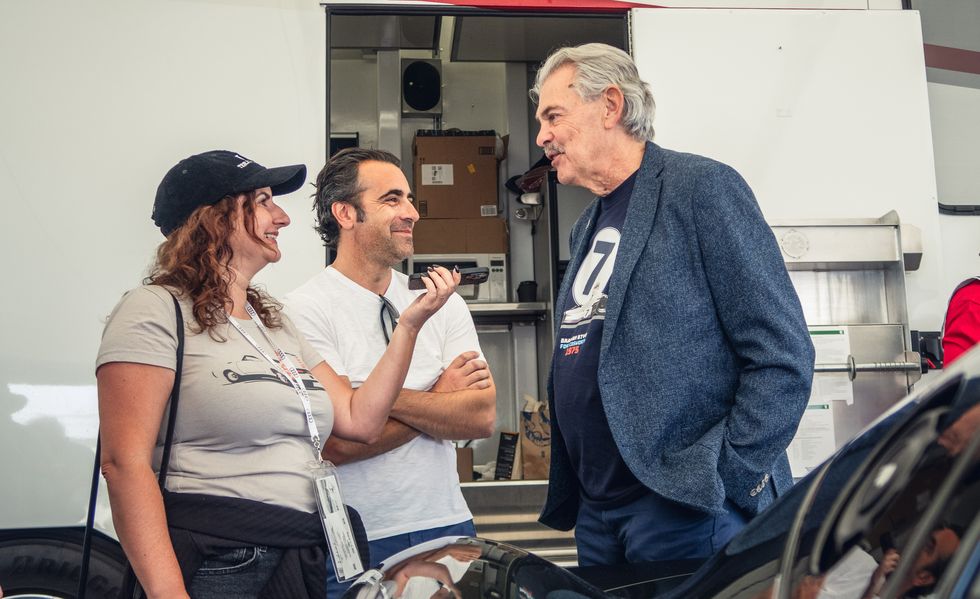
Simari Photography LLC|Car and Driver
Was this number based on a performance goal or is it another competitive one?
It was based on beating the current [production car] record. When I went to Cosworth on my first meeting, I mentioned another one of my cars, which is the Light Car Company Rocket, which uses a little motorcycle engine and that revved to 11,500. I walked into Cosworth and said 12, and their eyes rolled a bit, and they didn’t come back to me immediately, but within two months, they came back and said, We think we can get to 12.
What would you have done if they’d said they couldn’t do it?
I probably would have shot somebody.
Dario Franchitti: And then told them they had to do it. And then they’d have come back and worked at it again. He’s very good at getting his own. [Murray ignores Franchitti again. Franchitti winks.]
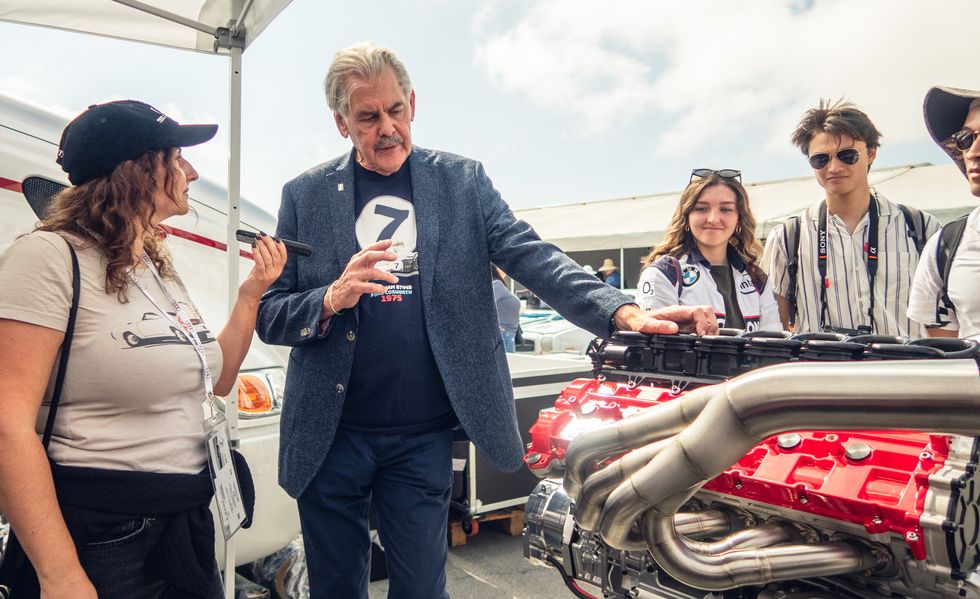
Simari Photography LLC|Car and Driver
Was there any point in the design where you were considering using an engine that already existed or modifying an engine that already existed?
I wouldn’t have done the program without the bespoke engine and without it being a normally aspirated V-12, I would not have even started.
Every single piece on this car is engineering art. It took months to get the right feel on the switches . . . If you do both styling and engineering, you have only yourself to argue with.
Why was this high-revving V-12 so important to you? Why not a turbo eight or six even?
Well, first of all, I’ve always said, with a supercar the engine is probably at least 50 percent of the driving experience. It’s basically the heart of the car. And it makes such a difference whether the engine’s bright and alive and responsive, or lazy or turbocharged. For me, the ultimate motor should never be turbo because you can never get the immediate response, no matter what you do. People tell you they’ve got electric motors spinning the turbos up, they’ve gone to six turbos instead of two. You’ll still never ever get an instant response, and you’ll never get the sound, because the turbo is part of the exhaust system.
The next thing was how many cylinders. When it comes to motors, 12 cylinders is about the optimum limit. A V-12, if it’s got a 60-degree or 65-degree included angle in the V, that’s perfect primary balance, so you don’t need a flywheel. If you want engine response, keep the bits light and no flywheel and that’s going to rev up quick. Going more than 12 cylinders is exotic, but it’s not a very clever idea, because the frictional losses in a motor are exponential with the revs going up and the number of cylinders. Obviously, as you add cylinders, you get more friction. And if you go down to eight cylinders, you’ve got a very lumpy, not balanced engine.
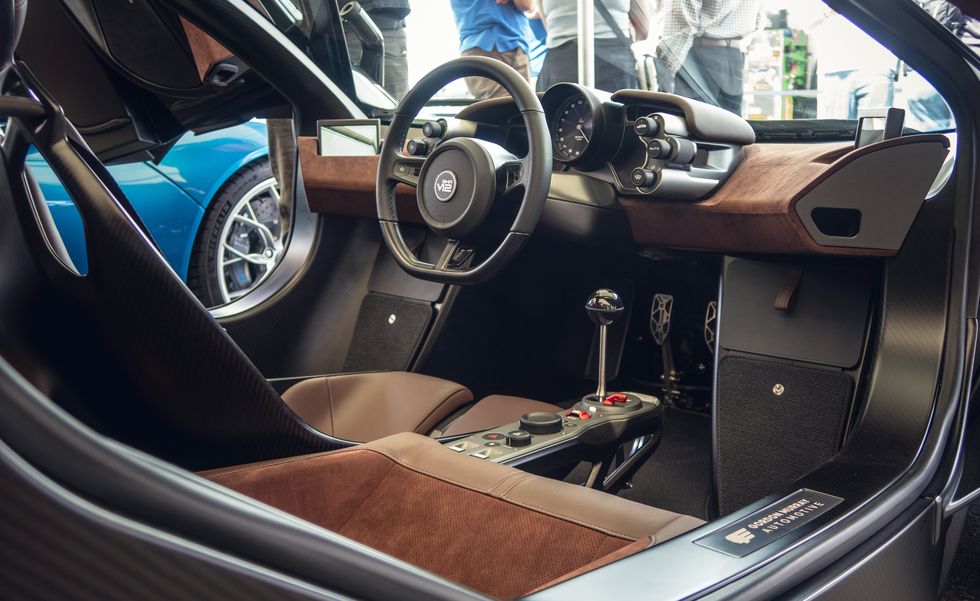
Simari Photography LLC|Car and Driver
How does that fit in this new landscape of supercar hybrids and electrics?
The F1 was very analog, very involving. I wanted the T.50 to be like that, a driver’s car. It has manual steering, but low-speed electric assist so you can park easily. A mechanical hand brake. The manual transmission. Room for suitcases. The customers for this car, they asked for these things. The other [hypercars], there’s nobody just focusing on the driving, they are always chasing numbers, 1600 horsepower. You can disguise a two-ton car, but you can’t change the laws of physics.
Did you have any issues keeping the car on this analog path?
I had so many rules: no touchscreen, thin steering wheel, no plastic. The plate over the gearchange is aluminum. Machining it takes hours. Every single piece on this car is engineering art. It took months to get the right feel on the switches, but to answer your question, no. If you do both styling and engineering, you have only yourself to argue with.

Senior Editor, Features
Like a sleeper agent activated late in the game, Elana Scherr didn’t know her calling at a young age. Like many girls, she planned to be a vet-astronaut-artist, and came closest to that last one by attending UCLA art school. She painted images of cars, but did not own one. Elana reluctantly got a driver’s license at age 21 and discovered that she not only loved cars and wanted to drive them, but that other people loved cars and wanted to read about them, which meant somebody had to write about them. Since receiving activation codes, Elana has written for numerous car magazines and websites, covering classics, car culture, technology, motorsports, and new-car reviews.







